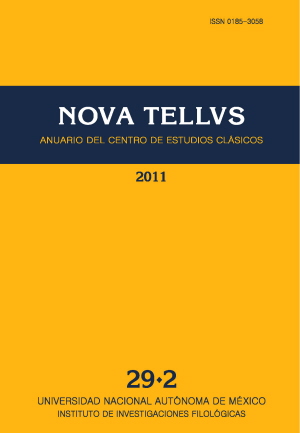Menenius Agrippaʼs Fable (Liv., II, 32-33)
Main Article Content
Abstract
In 494 a. C. in the course of the first seccesion of the plebs, Menenius Agrippa delivered a speech to the plebeians at the camp at Monte Sacro containingthe fable The Belly and the Limbs to persuade them to return to Rome. Livy recounts this event in his work Ab urbe condita (II, 32, 8-12), but he only reports the fable without giving further details of the speech. This study is aimed at analyzing the text on the basis of the rhetorical precepts. On the one hand, it tries to find out if the literaryform of the historical episode fits the form of an exemplum, and, on the other, it looks for the author’s purpose behind the choice of recounting solely the fable.
Downloads
Metrics
Vistas del PDF
1,254
Twitter
1
- Captures
- Mendeley - Readers: 3
Article Details
How to Cite
López Cruz, P. “Menenius Agrippaʼs Fable (Liv., II, 32-33)”. Nova Tellus, vol. 29, no. 2, Apr. 2013, doi:10.19130/iifl.nt.2011.29.2.389.
Issue
Section
Artículos
Copyright Notice
The authors who publish in NOVA TELLVS accept the following terms:
- The author or authors commit themselves to sign a Declaration of unpublished text and proprietary rights assignment authorizing the publication in the different platforms and spaces of diffusion of NOVA TELLVS and ceding the proprietary rights on the work in total and exclusive form to the Universidad Nacional Autónoma de México, according to article 84 of the Federal Law of Copyright and others relative and applicable to its regulation, in the understanding that the right of the author over the work will be respected, and the corresponding credit will be granted to them.
- All texts published by NOVA TELLVS—without exception—are distributed under the Creative Commons 4.0 Attribution - Non-Commercial (CC BY-NC 4.0 International), which allows third parties to use what has been published as long as they mention the authorship of the work and specify that the first publication was made in this journal.
- Authors may enter into other independent and additional contractual arrangements for the non-exclusive distribution of the version of the article published in NOVA TELLVS (e.g. including it in an institutional repository or making it known in other paper or electronic media) provided that it clearly and explicitly states that the work was first published in this journal.
- For all of the above, together with their proposed material, authors must submit the Declaration of unpublished text and proprietary rights assignment format of the first publication duly requisitioned and signed by the authors. This format should be sent as a PDF file to novatellus@unam.mx or iiflnovatellus@gmail.com


